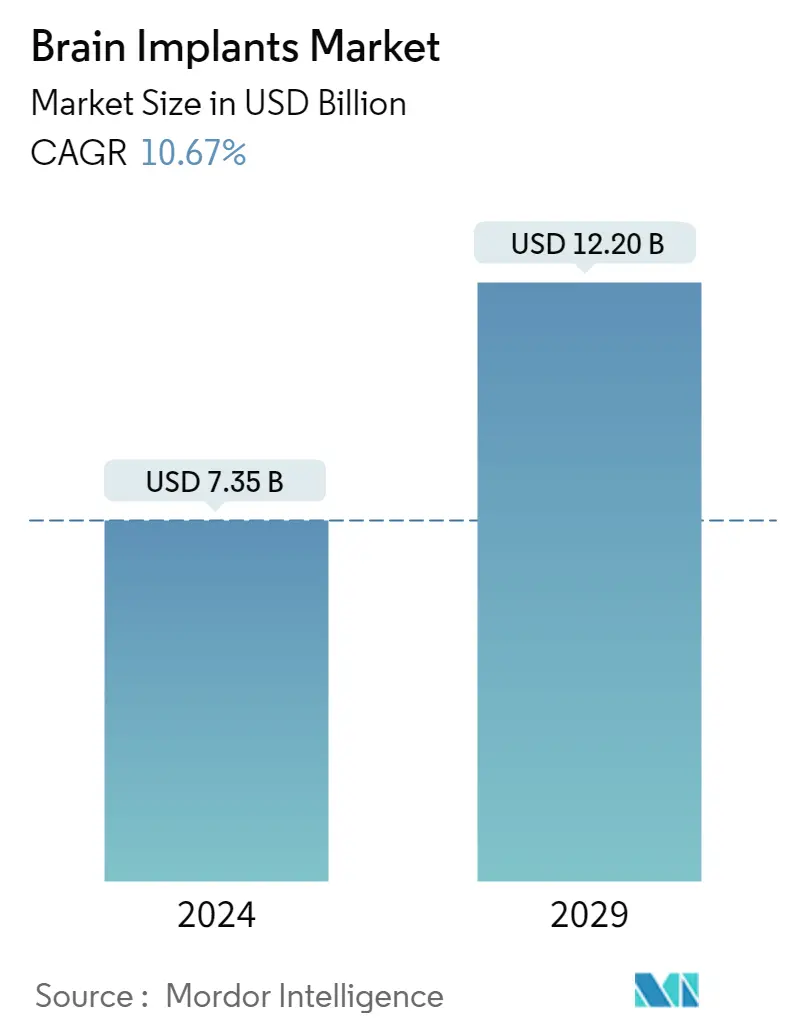Market Size of Brain Implants Industry

| Study Period | 2021 - 2029 |
| Market Size (2024) | USD 7.35 Billion |
| Market Size (2029) | USD 12.20 Billion |
| CAGR (2024 - 2029) | 10.67 % |
| Fastest Growing Market | Asia-Pacific |
| Largest Market | North America |
Major Players
*Disclaimer: Major Players sorted in no particular order |
Need a report that reflects how COVID-19 has impacted this market and its growth?
Brain Implants Market Analysis
The Brain Implants Market size is estimated at USD 7.35 billion in 2024, and is expected to reach USD 12.20 billion by 2029, growing at a CAGR of 10.67% during the forecast period (2024-2029).
The COVID-19 pandemic significantly impacted the growth of the brain implants market globally, due to the suspension and postponement of most elective surgeries and treatments. According to a research article published in medRXiV, 2021, the prevalence of SARS-COV2 viral infection in patients with Parkinson's disease was found to be 11.28%. Further, COVID-19 prevalence in Parkinson's disease patients with deep brain stimulation was found to be 18.18%. Thus, patients suffering from COVID-19 are prone to a high risk of developing neurological disorders during their hospital stays. The strict lockdown restrictions and measures taken to contain the viral transmission increased the chronic stress and burden of neurological disorders. This increased the urgent opening of neurological outpatient services. Thus, the brain implant market was significantly impacted during the pandemic. However, neurological surgeries evolved during the pandemic. For instance, in March 2021, an article published in Springer Nature Limited stated that the neurosurgical community's response to the initial phase of the pandemic, in at least three European countries, maintained high standards of care and low rates of acute mortality. Similarly, another article published in Frontiers Media S.A. in December 2021 stated that the deployment of telemedical services for patients with neurological and psychiatric conditions dramatically escalated as the pandemic evolved. Despite concerns about the format, scheduling, privacy, and reimbursement, the transition was relatively smooth with numerous reports underscoring patient satisfaction. Thus, the normalization of surgeries and the introduction of new methods are expected to increase market growth.
The major factors for the growth of the brain implant market include the rise in the aging population and an increase in the prevalence of neurological disorders and technological advancements in devices. The increase in the number of cases of neurological disorders, such as Alzheimer's, epilepsy, Parkinson's, depression, and essential tremors, is anticipated to propel the demand for brain implants. According to Parkinson's News Today 2021, an estimated 7 to 10 million people worldwide have Parkinson's disease, and approximately 60,000 Americans are diagnosed with this disease, thus, leading to promising growth. Similarly, according to the Parkinson's Foundation 2020, approximately 1.2 million people in the United States are estimated to suffer from Parkinson's disease by 2030. Brain implants are likely to reduce the need for drugs that relieve chronic pain and improve body movement in patients suffering from Parkinson's or any other neurological disease.
The growing geriatric population is also prone to several neurological disorders. According to the World Health Organization (WHO) October 2021 updates, around 1 in 6 people in the world will be aged 60 years or over by 2030, and by 2050, two-thirds of the world's population over 60 years will live in low- and middle-income countries. In such middle income countries the current infrastucture is not capable to provide care and constant monitoring and brain implants could provide that in such regions. Thus, the rising geriatric population, the brain implants market is expected to register significant growth over the forecast period.
Furthermore, collaborations by key market players are expected to increase the market growth as collaborations provide synergy of research and devlopment and required investment which increases the success rate of the program. For instance, in April 2022, a collaborative project between Queensland Brain Institute (QBI) together with Neurosciences Queensland and Abbott Neuromodulation developed a remote care platform that uses wireless technology in brain implant technology to allow patients to access treatment from anywhere in the world. This new technology will link to developing brain-reading devices, such as implants in the brain. Thus, the abovementioned factors such as the increasing prevalence of neurological disorders and collaborations are expected to increase market growth over the forecast period. However, the high cost of devices and low adoption rates in developing and underdeveloped regions are expected to hinder the market growth.
